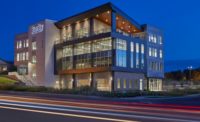Kansas City, Mo.-based engineering firm Burns & McDonnell finished work last year on a $3.7-million program to raise 10 bridges on Interstate 35 for the Kansas Transit Authority. Burns & McDonnell handled engineering, procurement and construction for lifting the 10 spans, some from as low as 14 ft 6 in. to at least 15 ft 9 in., all to aid freight movement on the turnpike and decrease commercial traffic on local roads and highways.
It’s not the biggest or most attention-grabbing project from Midwest design firms, but it’s emblematic of a region that is demanding more modern roads for shipping manufactured goods at the same time that it finds new ways to distribute energy products ranging from natural gas, solar and wind power.
The 120 firms that appear in this year’s Top Design Firm ranking saw their work expand to new heights just like those 10 bridges. They also accommodated clients by offering services that go beyond traditional engineering or architecture deliverables.
ENR Midwest 2018 Top Design Firms
“It’s a good time to be in our business,” says Ray Kowalik, Burns & McDonnell’s CEO. “That’s our employee-ownership model at work. We have a safety net to test and prove innovative ideas. Once those ideas are strong enough to live on their own, they will become their own business lines.”
Public-private partnerships, integrated delivery and use of the latest design technology all came to the forefront in a competitive year that saw Burns & McDonnell reach the top spot in ENR Midwest’s survey.
The power generation segment helped Burns & McDonnell’s ascent, with $261.45 million in power revenue alone. Kowalik says that market has been a focus of growth for the company ever since the power group was expanded in its Chicago office in 2016 under the leadership of Patricia Scroggin, the regional global practice manager for energy and an ENR Top Young Professional. Kowalik said there’s still room for future growth regionally and nationally for the power business.
The most successful firms in the Midwest diversified the services they offer in addition to pursuing the project delivery methods that today’s clients demand. Clients want more from design firms, and it is by delivering beyond contract documents that designers are able to set themselves apart from the competition. Firms are always looking to find what can be prefabricated or modularly designed early on in projects.
“We’ve been successful collaborating more closely with clients and construction partners to get involved in the solution development,” says Kouhaila (Ki) Hammer, president and CEO of Dearborn, Mich.-based Ghafari Associates (ranked No. 11 in the Midwest and No. 1 in Michigan). “Clients are increasingly more sophisticated and understand the value that can be gained from early involvement…. We’re in a unique position. We do everything from high-end design to manufacturing processes.”
Hammer said clients expect Ghafari to help them eliminate waste and address cost savings before a project starts as the industry moves toward a more integrated model of project delivery. Technologies that support better coordination and collaboration are key.
Of course, the design tools the top design firms apply to their projects go well beyond the 3D modeling and building information modeling that were once considered cutting edge.
Chicago-based EXP (ranked No. 39) delivered detailed renderings and animations of the $75-million Washington and Wabash Chicago Transit Authority station to demonstrate how its undulating wave of canopies weaves through the historic Wabash Avenue corridor as a counterpoint to the city grid. Burns & McDonnell was the construction manager and it was completed in August.
Kowalik said that Burns & McDonnell will hire 1,000 new people in 2018 alone, from roughly 80,000 résumés the company expects to receive during that period.
“What we look for in technology hires is people who have the capacity to continue to learn,” he says. “We aren’t selling a product — we’re offering a service — so it’s critical that we have the top talent in our industry.”
Much of the technology that Midwestern firms are developing isn’t just for client projects. Top firms are adopting these tech solutions as work processes.
Hammer says Ghafari applies technologies that foster effective team integration by facilitating more efficient, lean-inspired project workflows, improved information sharing, more fluid communication, better informed decision-making, more accurate data and greater accessibility for all involved parties. The firm also recently acquired Concept Design, a Grand Rapids firm with a strong western Michigan presence—an area in which Ghafari wasn’t well represented.
“We look for firms that bring a growth mentality and ones that are in markets we aren’t—or that provide additional services or when we need additional bench strength,” Hammer says. “They want to grow beyond where they’ve been able to on their own. This type of merger invigorates the mutual portfolios that inspires employees’ growth and development—key for staff retention.”
Note: An earlier version of this article stated both EXP and Burns & McDonnell worked on the design of the $75-million Washington and Wabash Chicago Transit Authority station. EXP was the sole design engineer while Burns & McDonnell was the construction manager.








Post a comment to this article
Report Abusive Comment